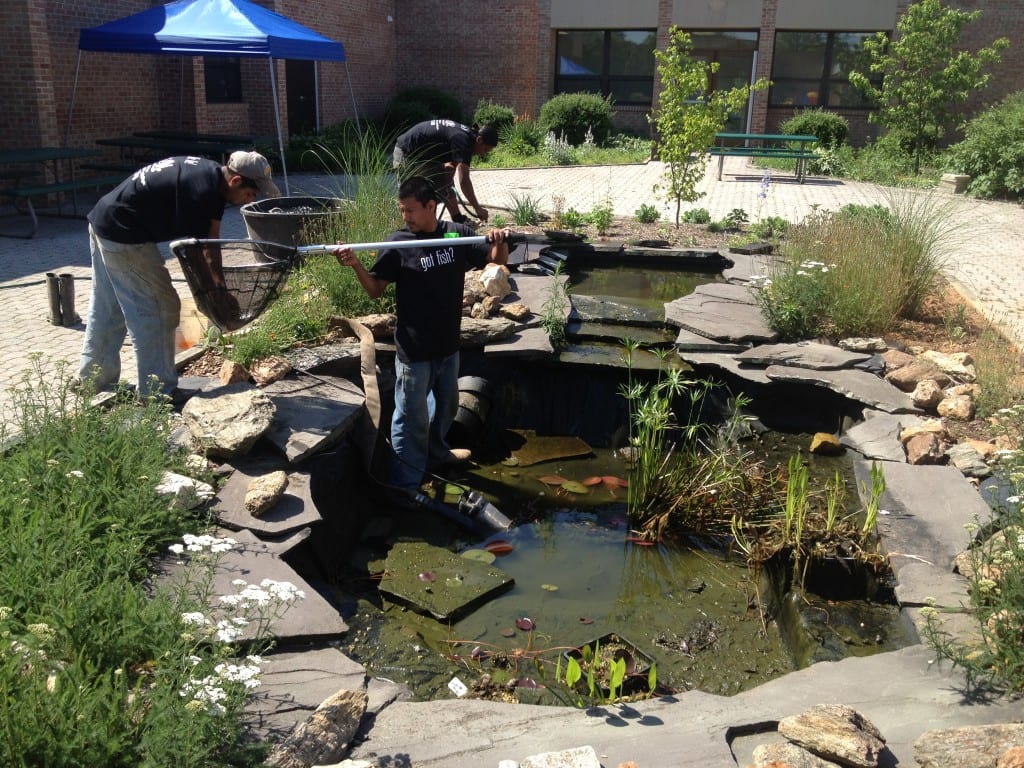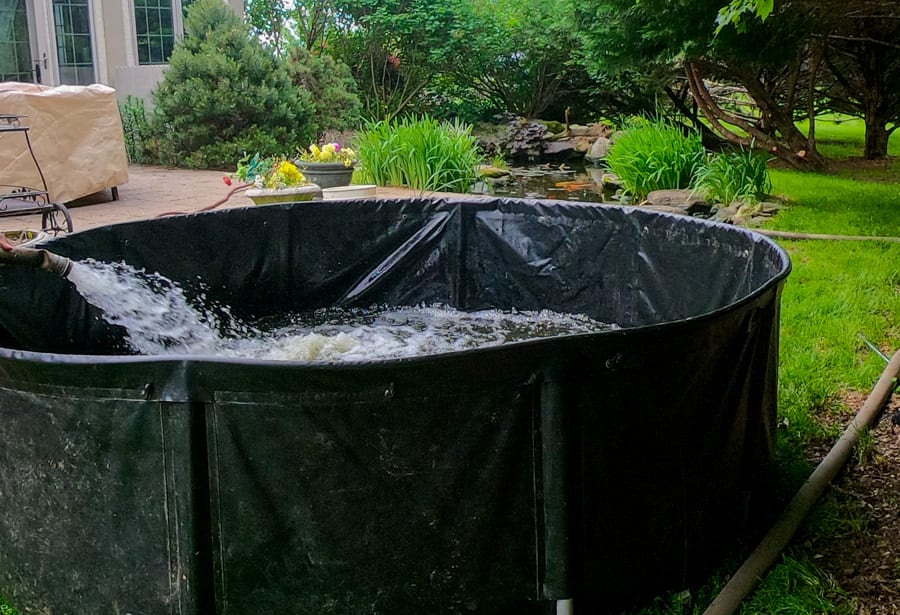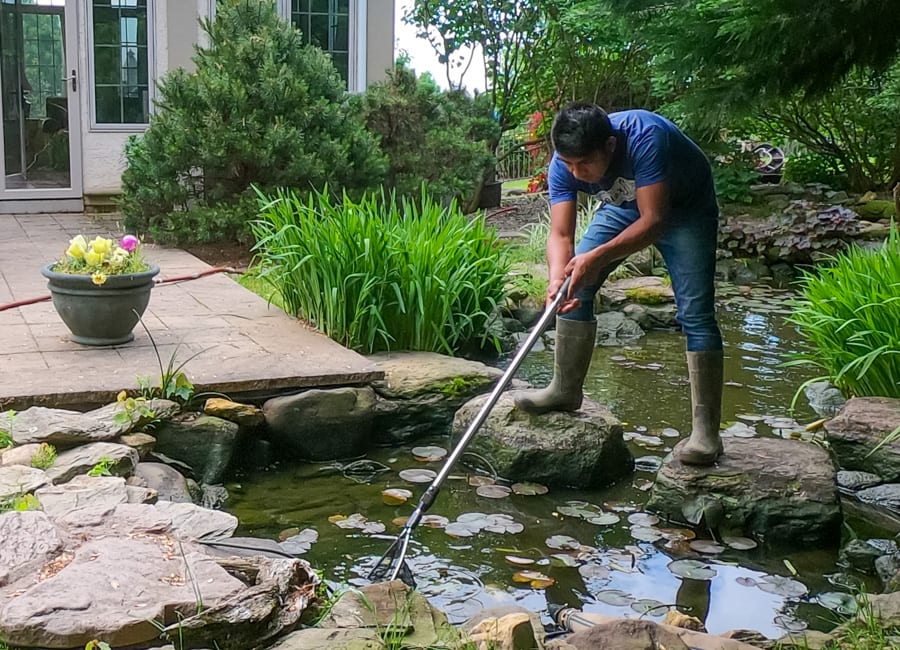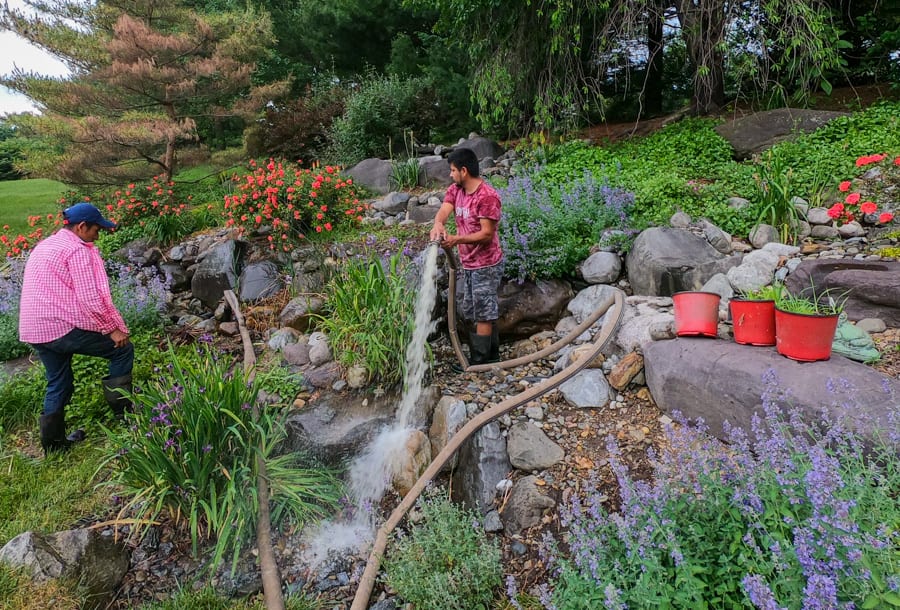What To Use To Clean Out A Pond
A well-congenital pond – one with a skimmer, biological filtration and enough of plants – will develop an ecosystem that more or less cleans itself.
Sometimes, though, manmade ponds demand help flushing out excess muck and debris. That's where a pond make clean-out comes in.
Cleaning a backyard pond takes a niggling time and elbow grease, merely, with the right tools, you tin knock out the make clean-out in a few hours and become dorsum to enjoying your crystal-clear water and happy, healthy fish.
(Don't want to clean your pond yourself? Click here to have u.s. practice the dirty work for you.)
In This Guide: How to Clean a Pond
- Why Should I Clean My Pond?
- How Often Should I Clean My Swimming?
- Swimming Make clean-Out Checklist
- How to Clean a Pond
- Step i: Ready a Temporary Fish Tank
- Step 2: Fill the Tank and Move the Fish
- Pace iii: Clean the Stream and Get-go Shelf
- Step iv: Empty, Clean, Repeat
- Step 5: Spruce Up Pond Equipment and Plants
- Footstep 6: Refill the Pond
- Stride 7: Relish Your Clean Swimming
Why Should I Clean My Pond?
Let's talk a trivial nearly swimming pattern and how it plays into your pond clean-out programme.
A backyard pond should have three features that keep cleaning needs to a minimum: a skimmer, a biofilter and plants.
The skimmer removes virtually large droppings – i.due east. dead leaves – from the h2o'southward surface before information technology has a run a risk to sink to the bottom and disuse.
The biofilter is a place with lots of nooks and crannies where benign bacteria grow. These leaner swallow excess nitrites that would otherwise feed dark-green-water-causing algae.
Plants remove another kind of food from the pond: nitrates. Without plants, nitrates will flourish and feed cord algae.
With these features in place (plus an appropriate number of fish and a few other blueprint tricks), you will create a largely self-sustaining ecosystem, like to the ones that continue ponds cute in nature.
So why do backyard ponds need periodic make clean-outs?
In nature, spring rains make full streams and rivers, which, in plough, flush out the lakes and ponds.
Manmade ponds, however, are closed ecosystems. When you go far there and clean out the pond, you're recreating those processes that happen in nature.
The goal of a clean-out is not to scrub every speck of algae from every stone, only rather to remove congenital-up muck and debris.
How Oftentimes Should I Clean My Pond?
Nosotros recommend cleaning your pond every i to three years. Whether y'all're an annual cleaner or a once-every-three-years type of person depends on how much droppings y'all allow into your pond.
If you have all the right filtration and a reasonable number of fish – and yous meticulously empty your skimmer and apply sludge cleaner to break upward sunken pond gunk – you can probably go away with only doing a clean-out every three years.
Most people, however, can do good from cleaning their swimming once a year.
This cleaning should happen in early on leap if possible.
At this fourth dimension of year, the benign leaner colonies that keep your water clear are still waking up from wintertime dormancy. If yous await until mid-summer to clean the pond, you'll wipe out all these helpful microorganisms, causing the h2o to get through a green phase equally the bacteria re-constitute themselves.
Cleaning your swimming in early spring also gives you a adventure to clean up wintertime debris, spruce up plants and replace broken bulbs and other equipment before the start of the outdoor season.
Pond Clean-Out Checklist
 Here are the supplies you'll need to make clean out your pond:
Here are the supplies you'll need to make clean out your pond:
- A clean-out pump (if you don't want to use your regular pond pump)
- Belch hose
- Garden hose
- Garden shears
- A large container to safely hold fish
- A net or something similar to place over the fish container to proceed them from jumping out
- An aerator
- Large buckets or similar containers for collecting leaves and other large debris
- A net for communicable and moving fish
- Swimming Detoxifier
- Cold Water Beneficial Bacteria
- Waterproof gloves (optional)
- Waterlily fertilizer
- Replacement light bulbs and any other equipment needed for making repairs
Pace 1
Set Up a Temporary Fish Tank

Set up a large container where your fish can comfortably hang out while you make their home nice.
This tank needs to be large enough to hold all your fish and deep plenty to maintain a more-or-less consequent temperature. A large plastic storage container, empty swimming pool or pop-up koi tank (you can find them online) volition normally do the chore.
You lot'll also need an aerator – so the fish can breathe – and a net to cover the top of the tank – then the fish don't jump out. Keep the tank out of direct sunlight, and don't go on your fish there for more than a few hours.
STEP 2
Fill up the Tank and Move the Fish
 Utilize a pump and belch hose to move most 50 to 70 percent of your pond's water into the temporary tank.
Utilize a pump and belch hose to move most 50 to 70 percent of your pond's water into the temporary tank.
Y'all can either purchase a make clean-out pump and discharge hose or use your existing pond pump.
A clean-out pump will allow y'all remove more than water – usually downward to the last one-half-inch – while your existing pond pump will usually get out you with 2 to 3 inches of water in the bottom of the pond.
Next, use a net to catch your fish and gently move them to their temporary hangout.
Pace 3
Clean the Stream and Offset Shelf
Now it's time to start cleaning.
Use the pump and discharge hose to spray some of the remaining h2o from the pond over the stream, plant shelves and any other exposed areas. (This water volition menses back into the pond, making it look pretty nasty for the moment, but we'll accept care of that later.)
Your goal here is not to force per unit area wash every surface but rather to loosen all the muck stuck behind and betwixt the pond stone and gravel.
Why employ the h2o from the swimming instead of from a garden hose or pressure level washer?
For one, a discharge hose will provide the best mix of volume and power. A garden hose will usually be too weak to dislodge all the debris, while a pressure washer has way too much power and will wipe out all the microorganisms that proceed your water articulate. Nearly belch hoses will give yous just the right corporeality of ability to dislodge all the muck (we usually apply hoses with a bore between 1.5 and three inches).
Second, using water from the pond helps maintain even more of that footling ecosystem nosotros talked about earlier. You're already wiping out a lot of those helpful bacteria during the clean-out, then the more you can relieve, the better.
STEP 4
Empty, Make clean, Repeat
 Now information technology'south time to get rid of that mucky pond water and make clean the residual of the pond.
Now information technology'south time to get rid of that mucky pond water and make clean the residual of the pond.
Simply discharge some of the h2o into the surrounding landscape as you piece of work your way toward the bottom of the pond. This water is loftier in nutrients that grass and other plants love.
Later you drain some water, do another laissez passer with the hose over the newly exposed stone and gravel, so drain out some more than water. Echo until yous accomplish the bottom. You might want to intermission out the regular garden hose for final touches.
Recollect: Don't worry about removing the "biofilm" and other stuff on the surface of the rocks and plant pots. Focus on large debris like dead leaves and built-up sludge. In doing and then, don't feel obligated to pick up every unmarried rock to get behind it. The pressure from the hose should do enough.
A once-a-yr clean-out also offers an opportunity to clean the skimmer and biofilter. Just use the hose or pond h2o to spray down the filter mats, bioballs and whatever other media.
Once the biofilter is make clean, don't bear upon it once more until next season. You should just clean your biofilter once a year so the benign leaner inside have a hazard to abound.
Stride 5
Bandbox Up Pond Equipment and Plants
With everything tuckered, now'due south your take a chance to supplant broken bulbs, upgrade skimmers, install fish caves or do whatever other maintenance your pond needs to beginning the season right.
Y'all can also use this opportunity to clip or divide unruly plants and fertilize waterlilies and lotus. (Don't worry about fertilizing marginal plants; they'll receive enough of nutrients from the pond h2o).
STEP 6
Refill the Pond
 Utilise the pump and discharge hose to move water from the temporary fish tank back into your swimming.
Utilise the pump and discharge hose to move water from the temporary fish tank back into your swimming.
Gently move the fish back into the pond one time the water is deep enough to exercise so. Keeping them in this h2o makes their transition less stressful than throwing them in a pond with completely new h2o.
Next, use your garden hose to refill the balance of the swimming. If you use a municipal water source – or you just want to be extra safety – you must add Pond Detoxifier to the pond equally it fills upwards.
Pond Detoxifier
Do not skip this step. Municipalities care for their water with levels of chlorine and chloramines that are ordinarily unnoticeable to humans just extremely dangerous for swimming fish. These levels occasionally spike if the water company is performing maintenance.
To exist safe, use double the dosage of Pond Detoxifer recommended on the bottle.
STEP 7
Savor Your Clean Pond!
You did it!
Now you have a clean pond that volition bring you enjoyment all season long.
Don't panic if your pond water looks brownish or green in the days following the clean-out. Some discoloration is normal as debris settles and beneficial leaner colonies re-establish themselves. These issues volition ordinarily clear up on their own.
To keep you lot h2o clear, treat it at least once a week throughout the season with beneficial leaner. This production is completely safe for fish, and so feel gratis to utilize a higher dosage than is recommended on the bottle if you experience y'all need it. If the weather condition is still cool, use Cold Water Bacteria until the h2o warms up for the season.
Cold Water Bacteria
If you did your clean-out in the bound, don't start feeding your fish over again until the water temperature is consistently to a higher place 55 degrees. At that point, you can ease them into the season with a Common cold Water Food or Probiotic Food.
Cold Water Fish Food
Probiotic Fish Food
Desire us to make clean your swimming for you lot? Click hither to sign upward. We serve York, PA; Lancaster, PA; Harrisburg, PA and other parts of Cardinal Pennsylvania and Northern Maryland.
Related Manufactures
How to Go Your Pond Ready for Spring
3 Ways to Deal with Bound Cord Algae
How to Go along Swimming Water Clear – The Ultimate Guide
How to Care for Pond Fish – The Ultimate Guide
Our 5 Favorite Water Treatments
Source: https://splashsupplyco.com/how-to-clean-a-pond-in-7-steps/
Posted by: kulikowskitheaught.blogspot.com


0 Response to "What To Use To Clean Out A Pond"
Post a Comment